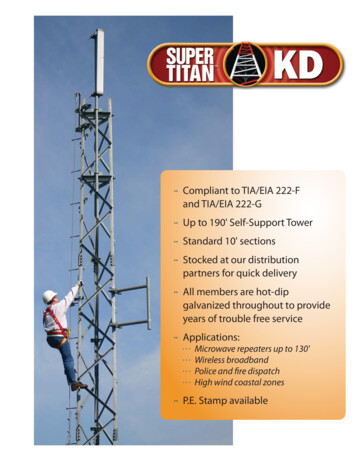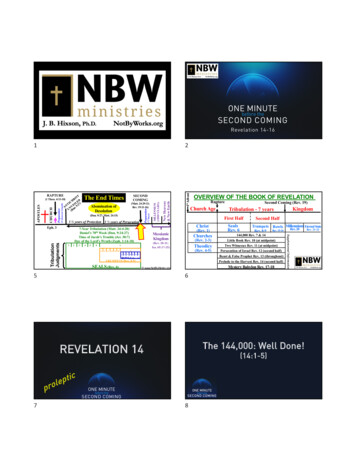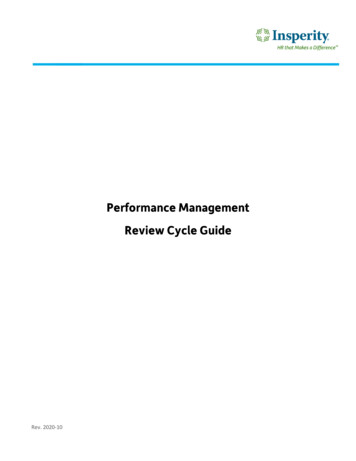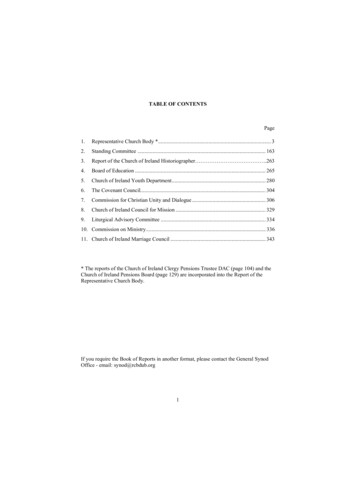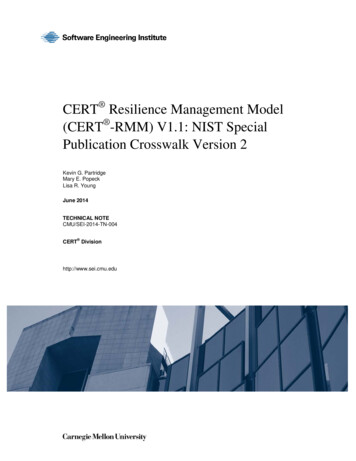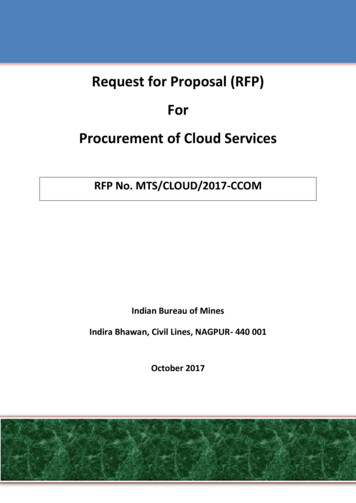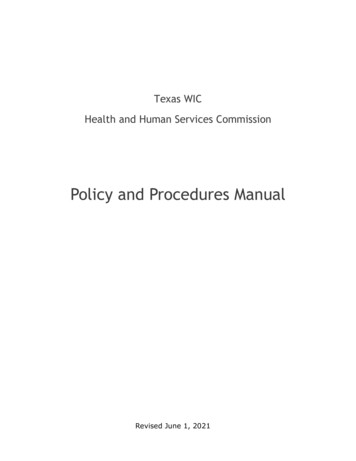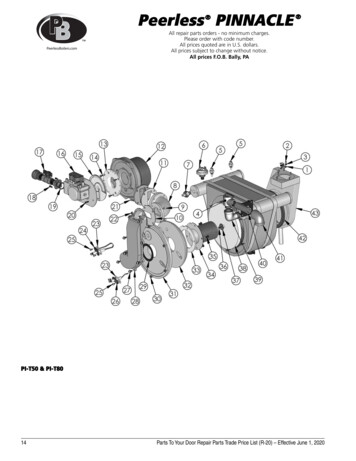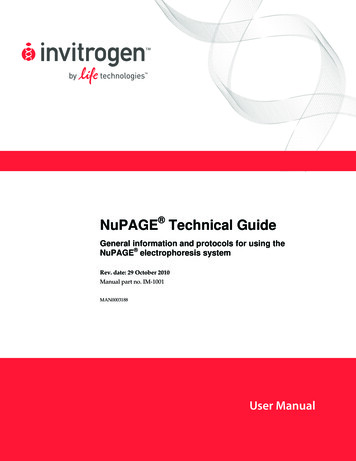
Transcription
NuPAGE Technical GuideGeneral information and protocols for using theNuPAGE electrophoresis systemRev. date: 29 October 2010Manual part no. IM-1001MAN0003188User Manual
2
ContentsNuPAGE Precast Gels. 5General Information .5Description of the NuPAGE Electrophoresis System .6NuPAGE Gel Specifications .8Gel Selection .9Well Volume.10Gel Staining .11Methods . 12General Guidelines for Samples and Buffers.12Preparing Buffers for Denaturing Electrophoresis .14Preparing Buffers for Non-Denaturing Electrophoresis .16Electrophoresis of NuPAGE Gels .17Opening Novex Pre-Cast Gel Cassettes.19Silver Staining .20Coomassie Staining .24SYPRO Ruby Staining .28Gel Drying .31Western Blotting .34Using ZOOM Gels .40Calibrating Protein Molecular Weight.42Troubleshooting.45Appendix. 48Accessory Products .48Recipes.50Gel Migration Chart .54Gel Conversion Chart.55Technical Support .56Purchaser Notification .58References .593
4
NuPAGE Precast GelsGeneral InformationPurpose of theGuideThe NuPAGE Technical Guide contains information about the NuPAGE Electrophoresis System and is intended to supplement the NuPAGE Bis-TrisGel Instruction Card (IM-8042) and the NuPAGE Tris-Acetate Gel InstructionCard (IM-1025). Complete protocols for sample preparation, buffer preparation,electrophoresis, staining, and blotting are provided in this guide.For additional information, contact Technical Support (see page 56) or downloadthe manuals from our website at www.invitrogen.com.For description of the NuPAGE electrophoresis system, see page 6–7.Storage and ShelflifeStore NuPAGE Novex Bis-Tris Gels at 4–25 C and NuPAGE Novex TrisAcetate Gels at 4 C.The NuPAGE Novex Bis-Tris Gels have a shelf life of 12 months when storedat 4–25 C.The NuPAGE Novex Tris-Acetate Gels have a shelf life of 8 months whenstored at 4 C.Do not freeze NuPAGE Gels.Using expired gels or improperly stored gels may result in poor bandresolution.PackagingThe NuPAGE Pre-Cast Gels are individually packaged in clear pouches with10 mL of Packaging Buffer.Handling the GelsThe Packaging Buffer contains low levels of residual acrylamide monomer and0.02% sodium azide. Gloves should be worn at all time when handling gels.Warning: This product contains a chemical (acrylamide) known to the state ofCalifornia to cause cancer. To obtain a SDS, see page 56.Intended UseFor research use only. Not intended for human or animal diagnostic ortherapeutic uses.5
Description of the NuPAGE Electrophoresis SystemIntroductionThe NuPAGE Bis-Tris Electrophoresis System is a revolutionary neutral pH,pre-cast, discontinuous SDS-PAGE mini-gel system providing maximumstability of both proteins and gel matrix during electrophoresis, and better bandresolution than other gel systems.The most widely used gel system for separating a broad range of proteins bySDS-PAGE is the Laemmli system (Laemmli, 1970). The highly alkalineoperating pH of the Laemmli system may cause band distortion, loss ofresolution, or artifact bands. The major causes of poor band resolution with theLaemmli system are:Advantages of theNuPAGE ElectrophoresisSystemNuPAGE ElectrophoresisSystemComponents Hydrolysis of polyacrylamide at the high gel casting pH of 8.7 resulting in ashort shelf life of 4–6 weeks Chemical modifications such as deamination and alkylation of proteins dueto the high pH (9.5) of the separating gel Reoxidation of reduced disulfides from cysteine containing proteins as theredox state of the gel is not constant Cleavage of Asp-Pro bond of the proteins when heated at 100 C in theLaemmli sample buffer, pH 5.2 (Kubo, 1995).The neutral operating pH (pH 7.0) of the NuPAGE Gels and buffers providefollowing advantages over the Laemmli system: Longer shelf life of 8–12 months due to improved gel stability (see page 5) Improved protein stability during electrophoresis at neutral pH resulting insharper band resolution and accurate results (Moos et al, 1998) Complete reduction of disulfides under mild heating conditions (70 C for10 minutes) and absence of cleavage of Asp-Pro bonds using the NuPAGE LDS Sample buffer (pH 7.0 at 70 C) Reduced state of the proteins maintained during electrophoresis andblotting of the proteins when using the NuPAGE AntioxidantThe NuPAGE Electrophoresis System consists of: NuPAGE Novex Bis-Tris [Bis (2-hydroxyethyl) imino-tris(hydroxymethyl) methane-HCl] Pre-Cast Gels for separating small to midsize molecular weight proteinsNuPAGE Novex Tris-Acetate Pre-Cast Gels for separating largemolecular weight proteinsNuPAGE LDS (Lithium dodecyl sulfate) Sample BufferNuPAGE Reducing AgentNuPAGE AntioxidantNuPAGE MES [2-(N-morpholino) ethane sulfonic acid] SDS or MOPS [3(N-morpholino) propane sulfonic acid] SDS Running Buffer for NuPAGE Novex Bis-Tris GelsNuPAGE Tris-Acetate SDS Running Buffer for NuPAGE Novex TrisAcetate GelsNuPAGE Transfer Buffer for blotting of NuPAGE Novex Pre-Cast GelsContinued on next page6
Description of the NuPAGE Electrophoresis System, ContinuedNuPAGE Bis-TrisDiscontinuousBuffer SystemNuPAGE TrisAcetateDiscontinuousBuffer SystemSeparation Rangeof ProteinsThe NuPAGE Bis-Tris discontinuous buffer system involves three ions: Chloride ( ) from the gel buffer and serves as a leading ion due to its highaffinity to the anode relative to other anions in the system. The gel bufferions are Bis-Tris and Cl (pH 6.4). MES or MOPS ( ) serve as the trailing ion in the running buffer. The runningbuffer ions are Tris , MOPS /MES , and dodecylsulfate (pH 7.3–7.7). Bis-Tris ( ) is the common ion present in the gel buffer and running buffer.The combination of the lower pH gel buffer (pH 6.4) and the running buffer(pH 7.3–7.7) results in a significantly lower operating pH of 7 duringelectrophoresis.The NuPAGE Tris-Acetate discontinuous buffer system involves three ions: Acetate ( ) from the gel buffer and serves as a leading ion due to its highaffinity to the anode relative to other anions in the system. The gel bufferions are Tris and Acetate (pH 7.0). Tricine ( ) from the running buffer serves as the trailing ion. The runningbuffer ions are Tris , Tricine , and dodecylsulfate (pH 8.3). Tris ( ) is the common ion present in the gel buffer and running buffer. TheTris-Acetate system also operates at a significantly lower operating pH of8.1 during electrophoresis.The NuPAGE Gels have a wider range of separation on a single gel and alsoseparate proteins evenly through the low and high molecular weight rangescompared to existing gels. Due to these advantages, most proteins are wellresolved on one of the five NuPAGE gels (see Applications, page 9).By combining any of the NuPAGE Novex Bis-Tris Gels with the MES SDS orMOPS SDS Running Buffer, you can obtain six separation ranges for resolvingproteins over a wide molecular weight range of 1–200 kDa. The NuPAGE Novex Tris-Acetate gels resolve proteins in the molecular weight range of36–400 kDa.7
NuPAGE Gel SpecificationsIntroductionThe NuPAGE Novex Pre-Cast Gel cassette is 10 cm 10 cm in size, anddesigned for use with the XCell SureLock Mini-Cell and XCell6 MultiGel Unit(see page 48 for ordering information).NuPAGE Novex Pre-Cast Bis-Tris Gels are available for resolving proteins inthe range of 1–200 kDa, and NuPAGE Novex Pre-Cast Tris-Acetate Gelsresolve proteins in the range of 36–400 kDa (depending upon the acrylamidepercentage of the gel and buffer system being used). Refer to the Novex GelMigration Charts (page 54) to find the gel with the region of maximumresolution best suited for your sample.SpecificationsNuPAGE GelFormulationsGel Matrix:Acrylamide/BisacrylamideGel Thickness:1.0 mmGel Size:8 cm 8 cmCassette Size:10 cm 10 cmCassette Material:Styrene Copolymer (recycle code 7)Sample Well Configuration:1, 9, 10, 12, 15, 17-well, 2D-well, and IPG wellThe NuPAGE Novex Pre-Cast Gels are available in different acrylamideconcentrations (see the table below).The NuPAGE Gels do not contain SDS. However, they are designed forperforming denaturing gel electrophoresis (see Applications, next page).Gel TypeFormulationNuPAGE Novex Bis-Tris GelsBis-Tris-HCl buffer (pH 6.4),Acrylamide, Bis-acrylamide,APS, Ultrapure waterNuPAGE Novex Tris-Acetate GelsTris-base, Acetic acid,Acrylamide, Bis-acrylamide,TEMED, APS, Ultrapure waterCrosslinker8Stacking Gel4%3.2%Separating GelpH10%, 12%, 4–12%7.07%, 3–8%8.1The crosslinker concentration for the NuPAGE Novex Pre-Cast Gel rangesfrom 3.8–5% depending on the region of the gel.
Gel SelectionChoosing aNuPAGE Gel forYour ApplicationTo obtain the best results, it is important to choose the correct gel percentage,buffer system, gel format, and thickness for your application. NuPAGE PreCast Gels are compatible with protein sequencing using Edman sequencingfrom the gel, or from PVDF membranes.Review Applications (below), and Well Volume (page 10) to determine thetype of gel that is best suited for your application.Refer to the NuPAGE Gel Migration Chart (page 54) to find the gel with theregion of maximum resolution best suited for your sample. The leading proteinmolecules should migrate about 70% of the length of gel for best resolution.ApplicationsSeparation of proteins over a wide range of molecular weightsUse NuPAGE Bis-Tris Gels with NuPAGE MOPS SDS Running Buffer toresolve proteins (14–200 kDa) under denaturing conditions.Separation of low molecular weight proteinsUse NuPAGE Bis-Tris Gels with NuPAGE MES SDS Running Buffer Buffer toresolve small molecular weight proteins (2–200 kDa) under denaturingconditions.Separation of high molecular weight proteinsUse NuPAGE Tris-Acetate Gels with NuPAGE Tris-Acetate SDS RunningBuffer to resolve high molecular weight proteins (36–400 kDa) underdenaturing conditions, or with Novex Tris-Glycine Native Running Buffer toresolve high molecular weight proteins under non-denaturing (native)conditions.Note: Do not use the NuPAGE Bis-Tris Gels with NuPAGE MOPS or MESRunning Buffer without SDS for native gel electrophoresis. This buffer systemmay generate excessive heat resulting in poor band resolution. The protein ofinterest may not migrate very well in a neutral pH environment if it is notcharged.2D separation of proteinsThe ZOOM Gels are specifically designed for second dimensionelectrophoresis of 7.0 cm IPG strips.9
Well VolumeRecommendedLoading VolumesThe recommended loading volumes and protein load per band by the detectionmethod are provided in the table below.Note: The 9- and 17-wells are compatible with any eight-channel pipette usedfor loading samples from 96-well plates. An additional lane is included forloading protein molecular weight standard.Well Types1 well2D wellIPG well9 well10 well12 well15 well17 wellMaximum LoadVolumeCoomassie StainingSilver StainingImmunoblotting700 μL12 μg/band1.0 mm1.5 mm400 μL600 μL12 μg/bandScale your sampleload for thesensitivity of yoursilver staining kit.1.0 mm7 cm IPG StripN/AScale yoursample loadaccording to thesensitivity ofyour detectionmethod.1.0 mm28 μL0.5 μg/band1.0 mm1.5 mm25 μL37 μL0.5 μg/band1.0 mm20 μL0.5 μg/band1.0 mm1.5 mm15 μL25 μL0.5 μg/band1.0 mm15 μL0.5 μg/band1.0 mmChoosing theAppropriate Wellfor YourApplication10Maximum Protein Load Per Band by Detection MethodFor use with theSilverQuest orSilverXpress SilverStaining Kits, werecommend aprotein load of1 ng/band.Choose the type of well for your application based upon the volume of yoursample. The more wells a comb has, and the thinner the gel is, the lower thesample loading volume.Note: Proteins transfer out of a 1.0 mm gel more easily than from a 1.5 mm gel.
Gel StainingStaining NuPAGE GelsThe NuPAGE Novex Pre-Cast Gels are compatible with most silver stainingprotocols. We recommend using the SilverQuest Silver Staining Kit or theSilverXpress Silver Staining Kit (see pages 20–23) for silver staining ofNuPAGE Gels.The NuPAGE Novex Pre-Cast Gels are compatible with any of the standardCoomassie staining procedures. The protocols that are accelerated by heat arepreferable as the heat serves as a “fix” for proteins, especially smaller peptides.The SimplyBlue SafeStain and Novex Colloidal Coomassie Blue Staining Kit(see pages 24–27) are recommended for staining NuPAGE Gels.The NuPAGE Novex Pre-Cast Gels are also compatible with copper or zincstaining, and fluorescent stains like the SYPRO Ruby gel stain (see pages 28–30)11
MethodsGeneral Guidelines for Samples and BuffersGeneral information on the sample buffer and reducing agent is providedbelow. For sample and buffer preparation protocols, see page 14. Instructionsfor preparing running buffers for denaturing and non-denaturingelectrophoresis are provided on page 50–52.IntroductionRecommendedBuffersThe recommended running buffer and sample buffer for each NuPAGE Novex Pre-Cast Gel is listed in the table below. Prepare your sample in the appropriatesample buffer so that the final concentration of the sample buffer is 1X. Runningbuffer must be diluted to 1X final concentration before use.See page 48 for ordering information on pre-mixed buffers. See pages 50–52 forrecipes if you are preparing your own buffers.Gel Type Running Buffer Sample Buffer NuPAGE Novex Bis-TrisGel (SDS-PAGE)NuPAGE MES or MOPS SDSRunning BufferNuPAGE LDS Sample BufferNuPAGE Novex TrisAcetate Gels (SDS-PAGE)NuPAGE Tris-Acetate RunningBufferNuPAGE LDS Sample BufferNuPAGE Novex TrisAcetate Gels (Native-PAGE)Novex Tris-Glycine NativeRunning BufferNovex Tris-Glycine Native SampleBufferNuPAGE LDSSample BufferUse the NuPAGE LDS Sample Buffer for preparing samples when performingdenaturing gel electrophoresis with NuPAGE Gels. The slightly alkaline pH ofthe NuPAGE LDS Sample Buffer (pH 8.4) provides the optimal conditions forreduction of protein disulfide bonds, and denaturation.The NuPAGE LDS Sample Buffer is a 4X concentrated solution containingtwice as much dodecylsulfate as the 2X concentration of Novex Tris-GlycineSDS or Tricine SDS Sample Buffer. The buffer also contains more glycerol,resulting in increased viscosity.Bring the NuPAGE LDS Sample Buffer to room temperature (25 C) before useto make pipetting the buffer easier.Tracking DyeThe NuPAGE LDS Sample Buffer uses Coomassie G250 and Phenol Red astracking dyes instead of bromophenol blue. Coomassie G250 gives a sharp dyefront with both MES and MOPS SDS Running Buffers and migrates muchcloser to the moving ion front than bromophenol blue. Bromophenol blue runsmore slowly than some peptides with the MES SDS Running Buffer. Thisensures that small peptides do not run off the gel.The concentration of the tracking dye (Coomassie G250) is increased in theNuPAGE LDS Sample Buffer to enhance viewing of the dye front.Continued on next page12
General Guidelines for Samples and Buffers, ContinuedReducing AgentUse the NuPAGE Reducing Agent to prepare samples for reducing gelelectrophoresis. The NuPAGE Reducing Agent (10X) contains 500 mMdithiothreitol (DTT) and is available in a ready-to-use, stabilized liquid form.As an alternative, -mercaptoethanol can be used with NuPAGE Gels at a finalconcentration of 2.5%.Add the reducing agent to the sample up to an hour before loading the gel.Avoid storing reduced samples for long periods, even if they are frozen.Reoxidation of samples occur during storage and produce inconsistent results.NuPAGE AntioxidantUse the proprietary NuPAGE Antioxidant in the running buffer of the Upper(cathode) Buffer Chamber when performing electrophoresis under reducingconditions to prevent sample reoxidation and maintain the proteins in a reducedstate. DTT and -mercaptoethanol tend to remain at the top of the gel, and donot co-migrate with the sample in the neutral pH environment of NuPAGE Gels. Disulfide bonds are less reactive at neutral pH and less likely to reoxidizethan in higher pH systems, but some reoxidization may occur duringelectrophoresis in the absence of an antioxidant, and cause band diffusion.The NuPAGE Antioxidant migrates with the proteins during electrophoresis,and protects disulfide bonds and sensitive amino acids (e.g., methionine andtryptophan) from oxidizing.The NuPAGE Antioxidant is NOT compatible with gel systems other than theNuPAGE system because the antioxidant is not efficient at the higher pHs ofother gel systems. For best results, use the NuPAGE Antioxidant with reducedand alkylated samples.ImportantNuPAGE SDSRunning BufferDo not use the NuPAGE Antioxidant as a sample reducing agent. Theantioxidant is not efficient in reducing disulfide bonds on its own, and using it toreduce samples results in substantial background smearing in the lane due topartially reduced bands.Three types of NuPAGE Running Buffers are available for denaturingelectrophoresis: NuPAGE MES SDS Running Buffer is used with NuPAGE Novex Bis-TrisGels to resolve small molecular weight proteins NuPAGE MOPS SDS Running Buffer is used with NuPAGE Novex BisTris Gels to resolve mid-size proteins NuPAGE Tris-Acetate SDS Running Buffer is used with NuPAGE Novex Tris-Acetate Gels to resolve high molecular weight proteinsMES has a lower pKa than MOPS, making the NuPAGE MES SDS RunningBuffer faster than the NuPAGE MOPS SDS Running Buffers. The difference inion migration affects stacking and results in a difference in protein separationrange between these buffers.For native gel electrophoresis with NuPAGE Novex Tris-Acetate Gels, usethe Novex Tris-Glycine Native Running Buffer.13
Preparing Buffers for Denaturing ElectrophoresisMaterials Suppliedby the UserThe following reagents are needed to prepare samples for denaturingelectrophoresis. Ordering information for pre-mixed buffers is on page 48. Ifyou are preparing your own buffers, recipes are provided on page 50–52. Protein sample Deionized waterFor Sample Preparation NuPAGE LDS Sample Buffer NuPAGE Reducing AgentFor Running Buffer PreparationPreparingSamples NuPAGE MES SDS Running Buffer (for small proteins on NuPAGE BisTris Gels) NuPAGE MOPS SDS Running Buffer (for mid-sized proteins NuPAGE Bis-Tris Gels) NuPAGE Tris-Acetate Running Buffer (for NuPAGE Tris-Acetate Gels) NuPAGE AntioxidantInstructions are provided below to prepare reduced or non-reduced samplesfor denaturing gel electrophoresis using the NuPAGE Novex Bis-Tris or TrisAcetate Gels.For reduced sample, add the reducing agent immediately prior toelectrophoresis to obtain the best results.ReagentReduced SampleSamplex μL 2.5 μLNuPAGE LDS Sample Buffer (4X)NuPAGE Reducing Agent (10X)1 μLDeionized Waterto 6.5 μLTotal Volume10 μLRunning Reducedand Non-ReducedSamplesNon-reduced Samplex μL2.5 μL—to 7.5 μL10 μLFor optimal results, we do not recommend running reduced and non-reducedsamples on the same gel.If you do choose to run reduced and non-reduced samples on the same gel,follow these guidelines: Do not run reduced and non-reduced samples in adjacent lanes. Thereducing agent may have a carry-over effect on the non-reduced samples ifthey are in close proximity. If you are running reduced and non-reduced samples on the same gel, omitthe antioxidant (see page 13). The antioxidant will have a deleterious effecton the non-reduced samples. The bands will be sharper on NuPAGE Gelsrelative to other gel systems, even without the use of the antioxidant.Continued on next page14
Preparing Buffers for Denaturing Electrophoresis, ContinuedHeating SamplesHeat the sample for denaturing electrophoresis (reduced or non-reduced) at70 C for 10 minutes for optimal results.PreparingRunning BufferUse 1X NuPAGE SDS Running Buffer for electrophoresis of denaturedsamples.Reducing Conditions1.Prepare 1,000 mL of Running Buffer as follows:20X NuPAGE SDS Running Buffer (MES, MOPS, or Tris-Acetate) 50 mLDeionized Water950 mLTotal Volume1,000 ml2.Mix thoroughly and set aside 800 mL of the 1X NuPAGE SDS RunningBuffer for use in the Lower (Outer) Buffer Chamber of the XCell SureLock Mini-Cell.3.Add 500 μL of NuPAGE Antioxidant to 200 mL of 1X NuPAGE SDSRunning Buffer from Step 1 for use in the Upper (Inner) Buffer Chamber ofthe XCell SureLock Mini-Cell just prior to starting electrophoresis. Mixthoroughly.Non-Reducing Conditions1.Prepare 1,000 mL of Running Buffer as follows:20X NuPAGE SDS Running Buffer (MES or MOPS)Deionized WaterTotal Volume50 mL950 mL1,000 mL2.Mix thoroughly. Fill the Upper and Lower Buffer Chamber of the XCellSureLock Mini-Cell with this Running Buffer. If the antioxidant is not added to the Upper Buffer Chamber, reoxidation ofproteins during electrophoresis may cause certain bands to appear morediffuse. Prepare Running Buffer for the upper chamber with the antioxidant nolonger than half an hour before use. Antioxidant diluted in Running Bufferlooses effectiveness over time, resulting in gels that exhibit signs ofreoxidation (slightly fuzzier bands). If 0.5 mL of antioxidant is added to the total amount of Running Buffer (forUpper and Lower Buffer Chambers) by accident, the amount of antioxidantfalls below the effective concentration. Additional antioxidant can be addedto increase the concentration (2.5 mL antioxidant in 1 L Running Buffer),but this is not recommended because high current is generated and theantioxidant in the Lower Buffer Chamber is wasted.15
Preparing Buffers for Non-Denaturing ElectrophoresisMaterials Suppliedby the UserThe following reagents are needed to prepare samples for non-denaturingelectrophoresis with NuPAGE Novex Tris-Acetate Gels. Orderinginformation for pre-mixed buffers is on page 48. If you are preparing your ownbuffers, recipes are provided on page 51–52. Protein sample Deionized waterFor Sample Preparation Novex Tris-Glycine Native Sample BufferFor Running Buffer Preparation PreparingSamples forNovex Tris-Glycine Native Running BufferInstructions are provided below to prepare samples for non-denaturing (native)gel electrophoresis using the NuPAGE Novex Tris-Acetate Gels.ReagentSampleNovex Tris-Glycine Native Sample Buffer (2X)Deionized WaterTotal VolumeVolumex μL5 μLto 5 μL10 μLDo not heat samples for non-denaturing (native) electrophoresis.PreparingRunning BufferUse 1X Novex Tris-Glycine Native Running Buffer for electrophoresis ofsamples under non-denaturing (native) conditions.1.Prepare 1,000 mL Native Running Buffer as follows:Novex Tris-Glycine Native Running Buffer (10X)Deionized WaterTotal Volume2.100 mL900 mL1,000 mLMix thoroughly and use 800 mL of this Running Buffer in the Lower andUpper Buffer Chambers of the XCell SureLock Mini-Cell.Continued on next page16
Electrophoresis of NuPAGE GelsIntroductionInstructions are provided below for electrophoresis of NuPAGE Gels using theXCell SureLock Mini-Cell. For more information on the XCell SureLock MiniCell, refer to the manual (IM-9003). This manual is available on our website atwww.invitrogen.com or contact Technical Support (see page 56).If you are using any other electrophoresis mini-cell, follow the manufacturer’srecommendations.ImportantProcedure usingXCell SureLock Mini-CellTo ensure success with the NuPAGE Electrophoresis System, remember theimportant points listed below: Wear protective gloves and safety glasses when handling gels. Under no circumstances should Tris-Glycine SDS buffers be used withNuPAGE Gels for any denaturing gel electrophoresis (see page 46–47 forthe outcome of your results using incorrect buffers). Only use NuPAGE SDS buffers (see page 12). DO NOT BOIL samples. Heat samples at 70 C for 10 minutes (see page15). Inner and Outer Buffer Chambers must be filled with the recommendedamount of running buffer to prevent excessive heating (see below).XCell SureLock Mini-Cell require 200 mL for the Upper Buffer Chamber and600 mL for the Lower Buffer Chamber.1.Remove the NuPAGE Gel from the pouch.2.Rinse the gel cassette with deionized water. Peel off the tape from thebottom of the cassette.3.Gently pull the comb out of the cassette in one smooth motion.4.Rinse the sample wells with 1X NuPAGE SDS Running Buffer. Invert thegel and shake to remove the buffer. Repeat two more times.5.Orient the two gels in the Mini-Cell such that the notched “well” side of thecassette faces inwards toward the Buffer Core. Seat the gels on the bottomof the Mini-Cell and lock into place with the Gel Tension Wedge. Refer tothe XCell SureLock Mini-Cell manual (IM-9003) for detailed instructions.Note: If you are running just one gel, use the plastic Buffer Dam in place ofthe second gel cassette to form the Upper Buffer Chamber.6.Fill the Upper Buffer Chamber with a small amount of the Running Bufferto check for tightness of seal. If you detect a leak from Upper to the LowerBuffer Chamber, discard the buffer, reseal the chamber, and check the sealagain.7.Once the seal is tight, fill the Upper Buffer Chamber (Inner) with theappropriate 1X Running Buffer. The buffer level must exceed the level ofthe wells.Continued on next page17
Electrophoresis of NuPAGE Gels, ContinuedProcedure usingXCell SureLock Mini-Cell,continuedNote: If you are running reduced samples, remember to fill the Upper BufferChamber with 200 mL of running buffer containing the NuPAGE Antioxidant (see page 15).8.Load an appropriate volume of sample at the desired proteinconcentration onto the gel (see page 10 for recommended loadingvolumes).9.Load appropriate protein molecular weight markers (see page 48 forordering information).10.Fill the Lower (Outer) Buffer Chamber with 600 mL of the appropriate 1XRunning Buffer.Run your gels according to the following table:ElectrophoresisConditionsGel Type NuPAGE Novex Bis-Tris Gelswith MES SDS Running BufferVoltageExpected Current*Run Time200 V constant†Start: 110–125 mA/gel35 minutesEnd: 70–80 mA/gelNuPAGE Novex Bis-Tris Gelswith MOPS SDS Running Buffer200 V constant†NuPAGE Novex Tris-AcetateGels150 V constant NuPAGE Novex Tris-AcetateNative GelsStart: 100–115 mA/gel50 minutesEnd: 60–70 mA/gelStart: 40–55 mA/gel1 hourEnd: 25–40 mA/gel150 V constantStart: 18 mA/gel 2 hoursEnd: 7 mA/gelRun timesmay vary† Recommended voltage for 9 and 17-well gels is 150–175 voltsProcedure forNuPAGE TurboProtocolAn optional accelerated process is available for achieving excellent separationand resolution in only 25 minutes when using NuPAGE Novex Bis-Tris Gelswith MES SDS Running Buffer.The voltage is set at 250 V constant with an expected current of 130–150 mA pergel, and a run time of 25 minutes.
NuPAGE MES [2-(N-morpholino) ethane sulfonic acid] SDS or MOPS [3-(N-morpholino) propane sulfonic acid] SDS Running Buffer for NuPAGE Novex Bis-Tris Gels NuPAGE Tris-Acetate SDS Running Buffer for NuPAGE Novex Tris-Acetate Gels NuPAGE Transfer Buffer for blotting of NuPAGE Novex Pre-Cast Gels . Continued on next page . 6
